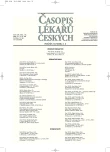Metabolic Effects of the Endocannabinoid System
Authors:
T. Kvasnička
Authors‘ workplace:
III. interní klinika – klinika endokrinologie a metabolizmu 1. LF UK a VFN, Praha
Published in:
Čas. Lék. čes. 2008; 147: 81-84
Category:
Review Article
Overview
The endocannabinoid system (ECS) is an endogenous signalling system that plays an important role in the regulation of energy homeostasis and lipid and glucose metabolism-all of which can influence cardiometabolic risk. Endocannabinoids are involved in the appetite and body weight regulation. Central or peripheral stimulation of ECS favours metabolic processes that lead to weight gain, lipogenesis, insulin resistance, dyslipidemia, and impaired glucose homeostasis. ECS is tonically overactive in obese individuals. ECS appears to be a promising novel mechanistic pathway that modulates important aspects of the cardiovascular and metabolic function.
Key words:
endocannabinoids, anadamid, receptor: CB1, CB2, obesity, cardiometabolic risk.
Sources
1. Cota, D., Marsicano,G., Tschop, M. et al.: The endogenous cannabinoid system affects energy balance via centra I orexigenic drive and peripherallipogenesis. J. CIin. lnvest., 2003, 112, s. 423–431.
2. Engeli, S., Bohnke, J., Feldpausch, M. et al.: Activation of the peripheral endocannabinoid system in human obesity. Diabetes, 2005, 54, s. 2838–2843.
3. Izzo, A. A., Mascolo, N., Capasso, F.: The gastrointestinal pharmacology of cannabinoids. Cur. Opin. Pharmacol., 2001, 1, s. 597–603.
4. Munro, S., Thomas, K. L., Abu-Shaar, M.: Molecular characterization of a peripheral receptor for cannabinoids. Nature, 1993, 365, s. 61–65.
5. Mechoulam, R., Ben-Shabat, S., Hanus, L. et al.: Identification of an endogenous 2 - monoglyceride, present in canine gut, that binds to cannabinoid receptors. Biochem. Pharmacol., 1995, 50, s. 83–90.
6. Devane, W. A., Hanus, L., Breuer, A. et al.: Isolation and structure of a brain constituent that binds to the cannabinoid receptor. Science, 1992, 258, s. 1946–1949.
7. Sugiura, T., Kondo S., Sukagawa A. et al.: 2-Arachidonoylglycerol: a possible endogenous cannabinoid receptor ligand in brain. Biochem. Biophys. Res. Commun., 1995, 215, s. 89–97.
8. Kvasnička, T.: Endokanabinoidy – nová možnost v léčbě metabolického syndromu a odvykání kouření. Čas. Lék. čes., 2005, 144, s. 81–84.
9. Sharkey, K. A., Pittman, Q. J.: CentraI and peripheral signaling mechanisms involved in endocannabinoid regulation of feeding: a perspective on the munchies. Sei STKE, 2005, 5, s. 2210–2112.
10. Di Marzo, V., Matias, I.: Endocannabinoid control of food intake and energy balance. Nat. Neurosci., 2005, 8, s. 585–589.
11. Hao, S., Avraham, Y., Mechoulam, R., Berry, E. M.: Low dose anandamide affects food intake, cognitive function, neurotransmitter and corticosterone levels in diet-restricted mice. Eur. J. Pharmacol., 2000, 392, s. 147–156.
12. Jamshidi, N., Taylor, D. A.: Anandamide administration into the ventromedial hypothalamus stimulates appetite in rats. Br J Pharmacol. 2001, 134, s. 1151-1154.
13. Kirkham, T. C., Williams, C. M., Fezza, F., Di Marzo, V.: Endocannabinoid levels in rat limbic forebrain and hypothalamus in relation to fasting, feeding and satiation: stimulation of eating by 2-arachidonoyl glycerol. Br. J. Pharmacol., 2002, 136, s. 550–557.
14. Osei-Hyiaman, D., DePetrillo, M., Pacher, P. et al.: Endocannabinoid activation at hepatic CBl receptors stimulates fatty acid synthesis and contributes to diet-induced obesity. J. Clin. Invest., 2005, 115, s. 1298–1305.
15. Lichtman, A. H., Cravatt, B. F.: Food for thought: endocannabinoid modulation of lipogenesis. J. Clin. Invest., 2005, 115, s. 1130–1133.
16. Sipe, J. C., Waalen, J., Gerber, A., Beutler, E.: Overweight and obesity associated with a missense polymorphism in fatty acid amide hydrolase (FAAH). Int. J. Obes. Relat. Metab. Disord., 2005, 29, s. 755–759.
17. Bensaid, M., Gary-Bobo, M., Esclangon, A. et al.: The cannabinoid CB1 receptor antagonist SR 141716 increases Acrp30 mRNA expression in adipose tissue of obese fa/fa rats and in cultured adipocyte cells. Mol. Pharmacol., 2003, 63, s. 908–914.
18. Kola, B., Hubina, E., Tucci, S. A. et al.: Cannabinoids and ghrelin have both central and peripheral metabolic and cardiac effects via AMPactivated protein kinase. J. Biol. Chem., 2005, 280, s. 25196–25201.
19. Pi-Sunyer, F. X., Aronne, L. J., Heshmati, H. M. et al.: RIO-North America Study Group: Effect of rimonabant, a cannabinoid-1 receptor blocker, on weight and cardiometabolic risk factors in overweight or obese patients: RIO-North America: a randomized controlled trial. JAMA, 2006, 295, s. 761–775.
Labels
Addictology Allergology and clinical immunology Angiology Audiology Clinical biochemistry Dermatology & STDs Paediatric gastroenterology Paediatric surgery Paediatric cardiology Paediatric neurology Paediatric ENT Paediatric psychiatry Paediatric rheumatology Diabetology Pharmacy Vascular surgery Pain management Dental HygienistArticle was published in
Journal of Czech Physicians

- What Effect Can Be Expected from Limosilactobacillus reuteri in Mucositis and Peri-Implantitis?
- Metamizole at a Glance and in Practice – Effective Non-Opioid Analgesic for All Ages
- Spasmolytic Effect of Metamizole
- Metamizole vs. Tramadol in Postoperative Analgesia
- The Importance of Limosilactobacillus reuteri in Administration to Diabetics with Gingivitis
Most read in this issue
- The Occurrence of Malignancies in Former Blood Donors
- Complications with the Pocket of Cardiostimulator
- Tracheal Intubation without Muscle Relaxant – the Impact of Different Sufentanil Doses on the Quality of Intubating Conditions: A Prospective Study
- Is the Extent of Present Examination of Blood Donors Sufficient? Malignancies in Active Blood Donors
